VVAM Newsletter 59 – 1995
Utrechtseweg 232 6862 AZ Oosterbeek The Netherlands
Translated by Cathrien and Peter Clark
FRIENDS OF THE AIRBORNE MUSEUM
Representative in Great Britain: Mr. E.E. Shaw, 298 Totnes Road Paignton – Devon TQ4 7HD Tel. 0803-553616
50 years ago: the first commemoration of the Battle of Arnhem
The 25th of September 1995 will see the 50th anniversary of the first Memorial Service which took place at the Airborne Cemetery in Oosterbeek, then still in the course of construction. The organisation of this commemoration of the Battle of Arnhem was in British/Dutch hands and its origins lay in a chance conversation between the (acting) burgomaster of Renkum, Mr. J. ter Horst, and the commander of the 1st British Airborne Division, Major-General R.E. Urquhart. They decided that a service should be held at the cemetery on the 17th of September of every subsequent year. Up to now that has been the case, with the excep¬tion that the date has changed with the passage of time. It remains 17 September when that date happens to fall on a Sunday, otherwise the service is held on the first Sunday following the 17th of that month.
From the very first commemo-ration, the ‘Pilgrimages’ to Arnhem and Oosterbeek by British and Polish guests were photographed by the Arnhem photo¬grapher Herman Truin. One of his photographs from 1945 accompanies this article. The book ‘We Will Remember Them’, available in two languages and containing Truin’s photographs of the first 25 anniversaries (1945-1969), can still be obtained from the Airborne Museum ‘Hartenstein’ in Oosterbeek and from the Airborne Forces Museum in Aidershot. The book comprises 126 pages of A4 format.
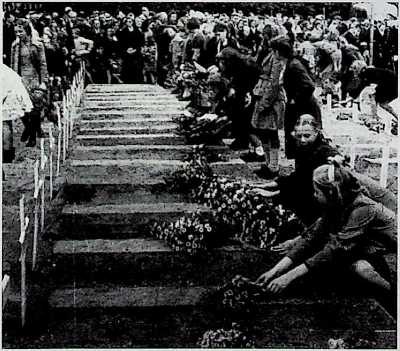
25 September 1945. Schoolchildren lay flowers on the graves at the Airborne Cemetery, Oosterbeek.
(photo; Herman Train)
Hamminkeln excursion a great success
On Saturday May 27 1995, 50 members of the Society of Friends of the Airborne Museum made an excursion to the area around Hamminkeln in Germany where, on 24 March 1945, the last great airborne operation of the Second World War took place. This operation, code-named ‘Operation Varsity’, was a success, due in part to the lessons learned from ‘Operation Market Garden’ in September 1944.
The bus left Oosterbeek at 9 a.m. for Hamminkeln, where we were received an hour later in the ‘Friedeshalle’. During the break for coffee our local guide, Mr. Johann Nitrowski, showed a 1945 film documentary of ‘Operation Varsity’ which gave an idea of the preparations for and the progress of the operation. After this we got under way on our ‘battlefield tour’.
With the aid of photographs and maps Mr. Nitrowski explained the actions which had taken place at seven different locations. Among the places where the excursion paused were the dropping and landing zones, Hamminkeln railway station, the bridges over the Issel, the Rhine at
Wesel plus a number of command posts, such as the Stallmannshof and Kopenhof farms.
Lunch was taken at Gasthuis Constance near the Diersfordter Wald. During the trip our driver, Rob Grotendorst, was given plenty of opportunity to demonstrate his driving skills when negotiating the narrow, winding lanes.
Apart from a few places around villages where building has taken place, the operational area has changed little in 50 years. This enabled the ’then and now enthusiasts’ to follow the events of 24 and 25 March 1945 with ease, using the maps and photos they had brought along.
There is insufficient space in this Newsletter to allow a thorough appraisal of all the facets of ‘Operation Varsity’ but, I can say to those who are interested, our magnificent guide Mr. Nitrowski will be publishing an extremely detailed book on the subject at the beginning of next year. More information will be provided in the Newsletter nearer the time. Tired but happy, the travellers arrived back in Oosterbeek at about 17.30.
Misters Nitrowski, Gerritsen, Voskuil, Van Roekel and Fennema; on behalf of all the participants, thank you for this fascinating excursion!
(Arie-Jan van Hees)
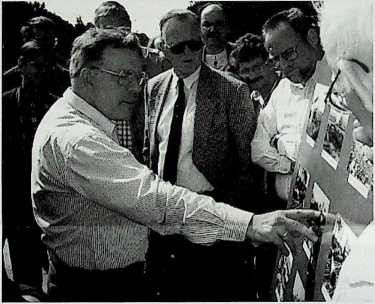
During the excursion to Hamminkeln on 27 May 1995, Mr. Nitrowski explains, with the aid of photographs, the landings of the 6th British Airborne Division.
(photo; Berry de Reus)
‘De Polen van Driel’ action raises 1,610 guilders
Two years ago Geert Maassen began ‘De Polen van Driel’ action. This meant that part of the sale price of the similarly titled book by the American/Polish author George F. Cholewczynski, sales of which were coordinated by Mr. Maassen, would go towards the Airborne Museum ‘Hartenstein’ renovation. The cooperation of the sellers of the book, the Oosterbeek book dealers Romijn and Meijer & Siegers, plus that of our association, was vital to this action.
The final amount raised was 1,610 guilders. This money went towards the purchase of a thermo-hygrograph, an instrument for constantly monitoring the temperature and relative humidity in the museum. Geert Maassen handed this useful piece of equipment over to the Airborne Museum Foundation management during an informal get-together on 8
June 1995. In his capacity as chairman, and on behalf of the management, Mr. J.W.A.M. Verlinden thanked all those who had participated in this action. Contrary to earlier reports, the price of the aforementioned book about the 1st Polish Independent Parachute Brigade Group has not since been increased; it remains at 25 guilders.
Gift of unusual film-camera
The Airborne Museum received yet another very unusual gift, namely a ‘Cine-Kodak 8’ camera, during the same meeting at which the thermo-hygrograph was presented. This very camera was used by Mrs. Clous and her husband to film events in the vicinity of their house at the corner of Lebretweg/Utrechtseweg in Oosterbeek in September 1944.
This resulted in a unique piece of 8 mm film showing British and German soldiers as well as civilians, a piece of film which has since been used in various documentaries about the Battle of Arnhem. Use has also been made of the Clous film in the videos which are to be seen at the Airborne Museum ‘Hartenstein’. Accompanied by her son, Mrs. I.E. Clous-Veen came to the ‘Hartenstein’ in order to present this unusual camera herself. She also used the opportunity to put on record, and once again to emphasise, that she too had played an important part in the making of what is known to many as ’the film of Clous the dentist’. Duly noted!
‘Light Warning Set’ now almost complete
Since the 1994 renovation the Airborne Museum’s attention has been focused on the two British ‘Light Warning Units’ used by the 1st Airborne Division in September 1944. Last year the Oosterbeek museum obtained the loan of an almost complete ‘A.M.E.S., type 6’ radar set from the Royal Netherlands Army and Weapons Museum in Delft. Following thorough refurbishment it is now on display in one of the upper rooms. The previously missing section of the ‘YAGl TV Type’ aerial has now been added. This three-part item was recently discovered by Mr. W. Boersma in the store-room of the Army museum. Mr. Boekhorst assisted in its restoration. The Airborne Museum ‘Hartenstein’ also managed to get hold of the appropriate frequency meter. The only items now missing are a number of connector cables.
Gift of equipment
For 50 years they lay stored in the attic of a house on the Utrechtseweg in Oosterbeek; a large quantity of original pieces of equipment belonging to British Airborne troops. The Van der Hoop brothers found them in 1945 in the area of Valkenburglaan and Sonnenberg. They reappeared during attic clearing operations, and have since been handed over to the Airborne Museum ‘Hartenstein’.
Great interest in ‘De Bevrijders’ (The Liberators) exhibition
The ’De Bevrijders’ exhibition which opened on April 5 1995 is attracting a lot of visitors. A large number of mannequins wearing the uniforms of the various army units which took part in the liberation of the Netherlands have been set up in the Airborne Museum’s new display room. The uniforms are in perfect condition, as are the associated items of equipment.
Virtually all of this authentic material comes from the private collection of Mr. W. Boersma, who is also responsible for arranging the exhibition. ‘The Liberators’ continues until 1 October 1995.
New conditions for those wishing to consult the archives and library
The conditions laid down by the Airborne Museum management concerning people wishing to consult the library or archives have, in practice, led to the need for further regulations. The somewhat supple wording of the original conditions has been the cause of disappointment and annoyance to some interested parties in the past. The modified regulations are as follows:
1. The library and archives are accessible on working days after first making an appointment with Mr. A.
—Groeneweg.-This.appointment must.be.made at least-
one week before the proposed visit (tel. 085-337710).
2. Archive material and books may be consulted under supervision. Material cannot be taken out on loan. Copies of documents and photographs subject to copyright cannot be provided. Copies of material which, in the view of the management, is not subject to copyright can be supplied within a reasonable timespan at cost price plus postage and packing costs.
3. Authors of a book or article in which use has been made of material lodged at the Airborne Museum ‘Hartenstein’ are obliged to provide the museum archive with one copy of said book or article, as a gift, on publication. Furthermore, the museum must be mentioned in the list of sources.
(A. Groeneweg)
Monument to the evacuation of Arnhem
Exactly fifty years after the liberation of Arnhem on 14 April 1945, a monument to the evacuation in September 1944 was unveiled in the capital of the province of Gelderland. It is a bronze plaque affixed to the wall of a building on the corner of Jansbuitensingel and Apeldoornseweg. This spot was chosen because many of the 93,000 Arnhem evacuees, forced to flee in the days following 23 September 1944, passed along this way.
The unveiling was carried out by four members of the ‘Comite Gedenkteken Evacues’ (Evacuees Memorial Committee) on 14 April 1995. The money for the monument was raised from private sources, companies and institutions in the Arnhem region. The publication of the book ‘Arnhem Spookstad’ (Arnhem Ghost Town) coincided with the unveiling of the monument. The book contains recollections and photographs of the evacuees, host families and those who stayed behind after the Battle of Arnhem, 1944-’45. It was compiled by Andre Horlings, was published by ELMAR b.v. in Rijswijk and costs 24,95 guilders.
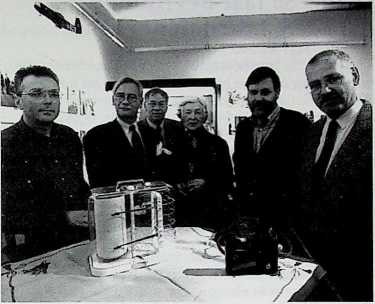
The hand-over of the thermo-hygrograph and the Cine- Kodak 8 camera on 8 June 1995. Left to right; Ceert Maassen, J. W.A.M. Verlinderu A. Groeneweg, Mrs. I.E. Clons-Veen and her son, and Mr. W. Boersma.
(photo; Berry de Reus)
German Order of Battle
During my recent visit to the Imperial War Museum in London my gaze happened to fall on the book ‘German Order of Battle 1944 – The Directory prepared by Allied Intelligence, of Regiments, Formations and Units of German Armed Forces. Originally published, London, British War Office, 1944, Reprint 1994′.
At last the British authorities have given permission for a reprint of this secret book on the order of battle of German forces at the time of the landings in Normandy. To my knowledge this is the only reference work that provides a detailed resume of the German forces up to regimental level. It was also used as a reference by all allied commanders.
It contains details about the organisation, concise information on the divisions and their commanders, the basic structure, identification codes, numbers and nature of the formations and units (divisions, higher formations and lower units). Also included are the ranks and make-up of the Waffen SS up to and including brigade level, help and semi-military organisations, foreign units, information about the higher officer echelons, lists of all regiments and divisions with codename, and an explanation of all abbreviations and codenames.
In short, an extremely useful reference work for those wishing to make a sensible contribution on the German army. It is not a war report but an absolute must for background information.
The book is published by Greenhill Books, Lionel Leventhal Ltd., Parkhouse 1, Russell Gardens, London NW11 9NN, London, the ISBN no. is ISBN 1-85367-170-3 and it costs 15,95 pounds sterling. (Chris van Roekel)
Airborne Museum’s cooperation in the ’50 Jaar Bevrijding’ (50 Years Liberation) event
The great ’50 Jaar Bevrijding’ event took place at the Soesterberg air base between 28 April and 8 May 1995. Various Dutch military museums took part, including the Oosterbeek museum. Mr. Boersma advised on the special exhibition at Soesterberg and the ‘Hartenstein’ provided a large number of uniforms, objects and material for display. Together with the Liberation Museum from
Groesbeek, the Airborne Museum had a large stand at the information market.
The Society of Friends of the Airborne Museum’s sales stall was also present, manned (or ‘ladyed’) by Mrs. De Langen and Mrs. Sandbrink.
Mr. Boersma was also present in a PR role for the museum, and was available to answer questions and provide information.
The event attracted more than 470,000 visitors, due in part to the good weather.
Presentation of the first volume of the book ‘Blik Omhoog’ (Glance Upwards)
The first volume of the book ‘Blik Omhoog 1940- 1945’, by our member Cor Janse, was presented on 14 July 1995 during a well-attended meeting in the ‘Neder Veluwe’ building in the grounds of the Wolfheze Psychiatric Hospital. It is sub-titled ‘Wolfheze en de Zuid-Veluwe in oorlogstijd’ (Wolfheze and the South Veluwe in wartime).
This first book describes in great detail the lot of the inhabitants of the village of Wolfheze during the period 1939 up to and including 16 September 1944. In addition great attention is given to the events in the south western Veluwe area, with Wolfheze as the centre point for the author’s compass.
Volume 2, due out in the autumn of 1995, begins with the preliminary bombardments of Operation Market Garden and deals with the history of the area between Arnhem, Ede and Wageningen up to and including the liberation and rebuilding.
Volume 1 of ‘Blik Omhoog’ contains 400 pages of A4 format.
‘Victory in Europe’
During the year of the 50th anniversary of the liberation many new books appeared, focused on the ending of the Second World War. One of these is ‘The Imperial War Museum book of Victory in Europe’ by Julian Thompson, whose earlier works include ‘Ready for Anything – The Parachute Regiment at War, 1940-1982’.
In ‘Victory in Europe’ Thompson describes the eleven months needed following D-Day for the conquering of Western Europe, seen through the eyes of servicemen in the British land, sea and air forces. He has made use of diaries, letters and taped interviews, all of which are to be found in the Imperial War Museum. The book also includes a chapter on Operation Market Garden.
This well-prepared publication contains over a hundred photographs and colour reproductions of paintings. ‘Victory in Europe’ was published in London by the Imperial War Museum in conjunction with Sidgwick & Jackson, and costs 25 pounds sterling.
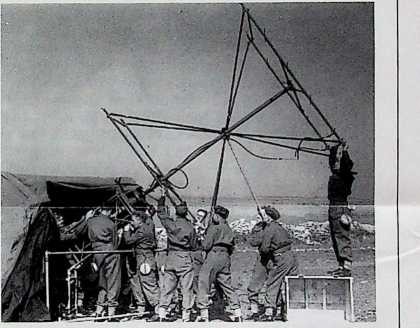
A photograph from the Second World War showing the setting up of a ‘Light Warning Set’ aerial, (photo; Airborne Museum ‘Hartenstein’ archives)
Appeal
For some time one of our members, Philip Reinders, has been engaged in compiling a list of names of all British and Polish servicemen who were involved on the ground in the Battle of Arnhem.
Each soldier will be listed with: name, initial(s), rank and unit (platoon, company, battalion). Philip would also like his survey to include the eventual fate of each individual, i.e. whether or not he returned across the Rhine or was made prisoner-of-war. As the reader will be aware, those soldiers who lost their lives are listed in Jan Hey’s ‘Roll of Honour’ (as far as these are known).
Unfortunately no complete, official list of names per unit exists and the summary now being worked on still contains many blanks. Anyone who thinks he can contribute to this work is asked to contact Philip Reinders, Delftseveerweg 37d, 3134 JG, Vlaardingen, telephone 010-4356704. Heartily recommended!

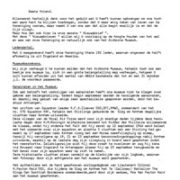
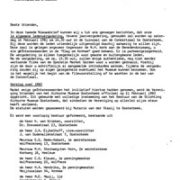
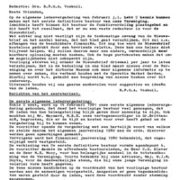
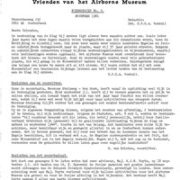
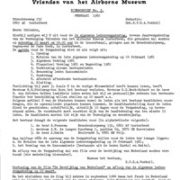
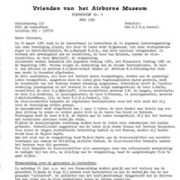
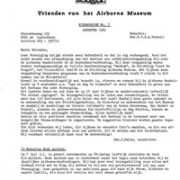
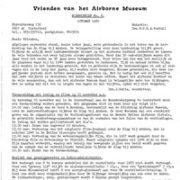
Plaats een Reactie
Vraag of reactie?Laat hier uw reactie achter.